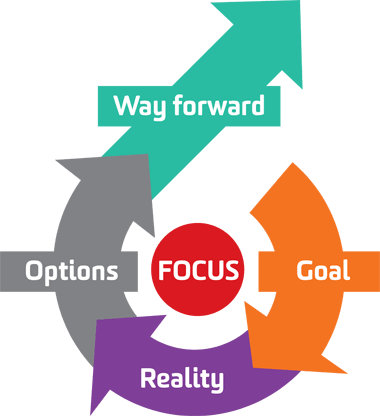In part 1 of this series I described on how I could help my team members raising self-awareness by building a habit of continuous feedback. This part will focus on how I tried to take action on my duties of understanding every person’s concerns and motivations and help them define the direction of their growth.
I started by doing some research on coaching models and processes and found out about the GROW model.
 The Grow Model
The GROW model, published in 1992 by John Whitmore in his book “Coaching for Performance”, is a simple but powerful framework that helps maximise and maintain personal achievement and productivity, through a sequence of phases and conversations. GROW stands for (G)oals, (R)eality, (O)ptions and (W)ay forward, which are the four pillars of this framework.
The first phase focuses on raising awareness on the person’s aspirations and broad goals, after which comes a reflection on his current reality and what steps are or have been taken towards those aspirations. In the third stage, a brainstorm is undertaken with the purpose of discovering approaches and ideas on how to effectively work towards the person’s goals. Finally, the last phase concentrates on materialising these ideas into concrete and effective actions.
Introspection Sessions
Using this model as a basis, I undertook a series of 1:1 sessions with my team members, where I experimented to initiate discussions around the GROW topics. After a few sessions, I compiled a list of questions that address these topics and began using them as starting points for discussions and as funnelling mechanisms. This allowed me to get much more value and content from these meetings.
These meetings became the first part of the process I started using, I called them Introspection Sessions
In these sessions, the Goals and Reality phases were addressed. Here are some examples of the questions I used:
Goal
- What do you want to achieve long term?
- What does success look like?
- How much personal control or influence do you have over your goal?
- What would be a milestone on the way?
- Is that realistic?
- Is that positive, challenging, attainable?
- What would you like to happen that is not happening now, or what would you like not to happen that is happening now?
Reality
- What is happening now? (what, where, when, who, how much, how often). Be precise if possible.
- Who is involved (directly and indirectly)?
- What is their perception?
- When things are going badly on this issue, what happens to you?
- What have you done about this so far?
- What results did that produce?
- What is missing in the situation?
- What is holding you back?
I found the best duration for these sessions was between 20 and 60 minutes. It allowed enough time to develop and dive deep into some subjects, without becoming too wearying.
Throughout these sessions, it is important to take notes and capture as much as possible. However, I realised I had to do so without deviating attention from the person and retain an engaging posture. One thing that helped was to regularly read the notes with the person, to ensure everything was captured and to summarise parts of the discussion.
In the next part of this series, I will continue to explain how I took the outputs of these sessions to create meaningful personal development paths and visions.







Top comments (1)
Some comments may only be visible to logged-in visitors. Sign in to view all comments.